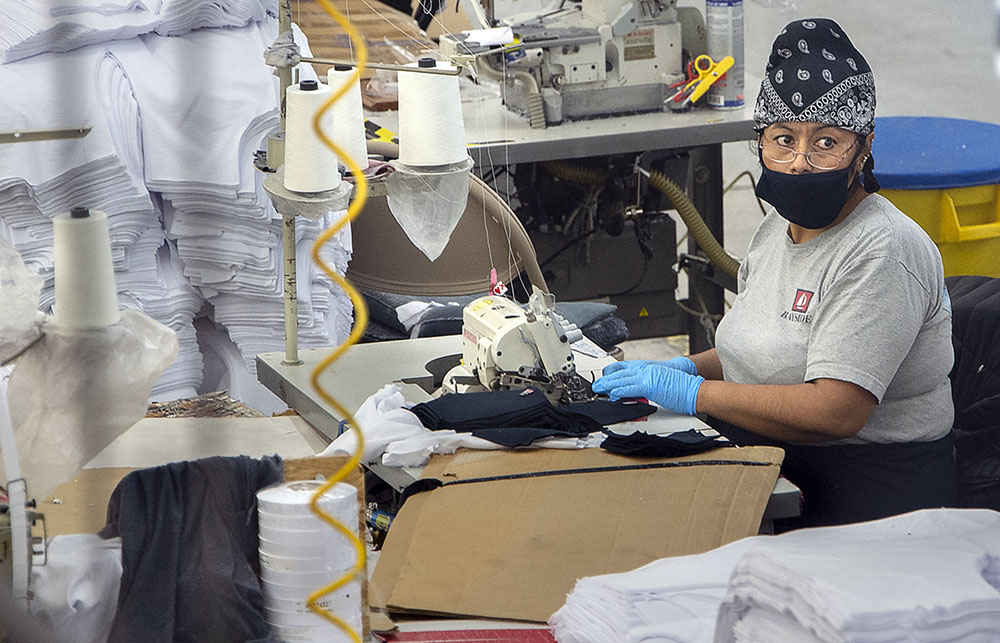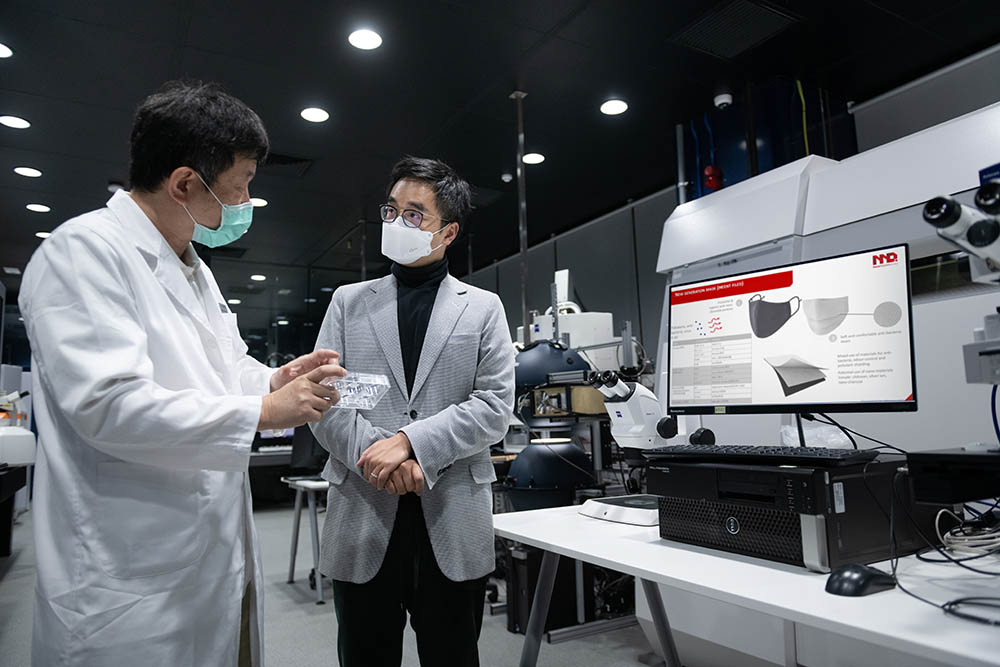
新型冠状病毒大流行导致医用外科口罩的需求空前激增。口罩可以提供一定保护,防止病毒传播,但在过滤空气中的病原体时会受到污染,最后反而可能提高传播疾病的风险。
研究人员正努力修复这一缺陷,希望能设计出功能更强大的口罩,使其可以杀死病毒和细菌,而非只是挡住它们。
“目前的口罩不能消灭病毒,所以建议一次性使用,但实际上不可能每隔几个小时就更换一次口罩,”阿尔伯塔大学的化学与材料工程系助理教授崔孝镇(音译)说道,他一直在开发能为医用外科口罩提供抗病毒涂层的产品以提高其安全性,秘诀就在于盐。
“我们用盐结晶处理口罩过滤层表面,不是公众熟知的细盐粉,”崔孝镇表示。涂层的工作原理是,首先吸收空气中通常携带病毒和其他病原体的水滴;水蒸发时,病毒会接触到盐结晶并被刺穿细胞膜从而达到杀灭效果。
崔孝镇在2017年首次展示了这项技术,不过是在实验室环境下,而且用的是单层口罩。标准外科口罩共有三层,内层用于过滤空气,两个夹层则用于防水和提升舒适性。
崔孝镇表示,2017年刚开始跟制造商交谈时,他们对提高口罩的安全性不感兴趣,只想提高舒适性。崔孝镇的最新研究兼顾两者,可以让口罩既透气又能高效过滤,5分钟内就能杀死病毒。
特别的钻石
在香港,医用外科口罩紧缺的形势促使政府对当地生产进行补贴。香港科技园的Master Dynamic工程实验室也在研究如何为医用口罩提供抗病毒涂层,不过使用的是另一种材料:纳米钻石。
“我们可以在不同隔层上都应用纳米钻石,这样一来就能全方位地杀死病毒,”Master Dynamics首席执行官汤姆·孔说道。根据孔教授的说法,纳米钻石可携带小电荷,与病毒接触时电荷会使细胞膜变性从而达到灭杀效果。
Master Dynamics以前在实际应用中使用过纳米钻石,用途包括作为药物输送的结合剂等。巧合的是,崔孝镇对盐作为抗病毒制剂的兴趣也是始于对改良药物输送系统的研究,当时他想用糖结晶作为结合剂研发可食用的疫苗。后来项目因糖结晶会破坏疫苗而失败,但启发了崔孝镇用结晶体作为抗病毒涂层的想法。

崔孝镇估计,用盐做涂层后每个口罩的成本价将增加50美分。Master Dynamics的团队尚未完成定价分析,但孔博士驳斥了钻石价格高昂的观点。
“人们一想到钻石,通常会想到价格高昂的珠宝。但我们使用的是工业级纳米钻石,而不是珠宝级钻石,因此要便宜得多,”孔博士说道。
工业级钻石经常用于研磨和切割其他材料,大部分都在中国的实验室里制造。孔博士表示,经过抛光变得锋锐,并切割成适合形状的钻石,才能成为Master Dynamics用作原材料的钻石“芯片”。
孔博士认为,口罩其实可以重复使用,因为纳米钻石的电荷能持续存在几个月,具体还需要测试。根据香港房地产开发商新世界发展公司公布的新闻稿,在首席执行官郑志刚指示下,该公司已经向Master Dynamics的研究投资了120万美元,初步结果预计将在未来四个月内公布。阿尔伯塔大学的崔孝镇相对领先一步,但也可能需要12到18个月时间才能推出可行的产品。
应用障碍
然而,即使产品能广泛生产,也无法保证届时会被执业医生们轻松接受。香港科技大学化学及生物工程系教授杨经伦表示,医学界在应用新产品方面表现得极为保守。
“防护装备方面,世界卫生组织对医疗专业人员该采用什么设备出具了指导意见,而且倾向于更加保守,因为世界卫生组织要确保所推荐设备适用于每个国家,”杨经伦说道。钻石和盐可能过不了关。(财富中文网)
译者:Feb
新型冠状病毒大流行导致医用外科口罩的需求空前激增。口罩可以提供一定保护,防止病毒传播,但在过滤空气中的病原体时会受到污染,最后反而可能提高传播疾病的风险。
研究人员正努力修复这一缺陷,希望能设计出功能更强大的口罩,使其可以杀死病毒和细菌,而非只是挡住它们。
“目前的口罩不能消灭病毒,所以建议一次性使用,但实际上不可能每隔几个小时就更换一次口罩,”阿尔伯塔大学的化学与材料工程系助理教授崔孝镇(音译)说道,他一直在开发能为医用外科口罩提供抗病毒涂层的产品以提高其安全性,秘诀就在于盐。
“我们用盐结晶处理口罩过滤层表面,不是公众熟知的细盐粉,”崔孝镇表示。涂层的工作原理是,首先吸收空气中通常携带病毒和其他病原体的水滴;水蒸发时,病毒会接触到盐结晶并被刺穿细胞膜从而达到杀灭效果。
崔孝镇在2017年首次展示了这项技术,不过是在实验室环境下,而且用的是单层口罩。标准外科口罩共有三层,内层用于过滤空气,两个夹层则用于防水和提升舒适性。
崔孝镇表示,2017年刚开始跟制造商交谈时,他们对提高口罩的安全性不感兴趣,只想提高舒适性。崔孝镇的最新研究兼顾两者,可以让口罩既透气又能高效过滤,5分钟内就能杀死病毒。
特别的钻石
在香港,医用外科口罩紧缺的形势促使政府对当地生产进行补贴。香港科技园的Master Dynamic工程实验室也在研究如何为医用口罩提供抗病毒涂层,不过使用的是另一种材料:纳米钻石。
“我们可以在不同隔层上都应用纳米钻石,这样一来就能全方位地杀死病毒,”Master Dynamics首席执行官汤姆·孔说道。根据孔教授的说法,纳米钻石可携带小电荷,与病毒接触时电荷会使细胞膜变性从而达到灭杀效果。
Master Dynamics以前在实际应用中使用过纳米钻石,用途包括作为药物输送的结合剂等。巧合的是,崔孝镇对盐作为抗病毒制剂的兴趣也是始于对改良药物输送系统的研究,当时他想用糖结晶作为结合剂研发可食用的疫苗。后来项目因糖结晶会破坏疫苗而失败,但启发了崔孝镇用结晶体作为抗病毒涂层的想法。
崔孝镇估计,用盐做涂层后每个口罩的成本价将增加50美分。Master Dynamics的团队尚未完成定价分析,但孔博士驳斥了钻石价格高昂的观点。
“人们一想到钻石,通常会想到价格高昂的珠宝。但我们使用的是工业级纳米钻石,而不是珠宝级钻石,因此要便宜得多,”孔博士说道。
工业级钻石经常用于研磨和切割其他材料,大部分都在中国的实验室里制造。孔博士表示,经过抛光变得锋锐,并切割成适合形状的钻石,才能成为Master Dynamics用作原材料的钻石“芯片”。
孔博士认为,口罩其实可以重复使用,因为纳米钻石的电荷能持续存在几个月,具体还需要测试。根据香港房地产开发商新世界发展公司公布的新闻稿,在首席执行官郑志刚指示下,该公司已经向Master Dynamics的研究投资了120万美元,初步结果预计将在未来四个月内公布。阿尔伯塔大学的崔孝镇相对领先一步,但也可能需要12到18个月时间才能推出可行的产品。
应用障碍
然而,即使产品能广泛生产,也无法保证届时会被执业医生们轻松接受。香港科技大学化学及生物工程系教授杨经伦表示,医学界在应用新产品方面表现得极为保守。
“防护装备方面,世界卫生组织对医疗专业人员该采用什么设备出具了指导意见,而且倾向于更加保守,因为世界卫生组织要确保所推荐设备适用于每个国家,”杨经伦说道。钻石和盐可能过不了关。(财富中文网)
译者:Feb
The coronavirus pandemic has prompted an unprecedented surge in demand for surgical masks, which offer some protection against the transmission of disease. However, masks become contaminated themselves as they filter pathogens from the air. As a result, they risk spreading more disease. That’s a design flaw researchers are currently trying to fix. They're working to design a better mask—one that can kill viruses and bacteria, rather than just trap them.
“Current masks don’t destroy the virus, that’s why they’ve been recommended for single use, but practically it is impossible to change the mask every few hours,” said Choi Hyo-jick, an assistant professor in the Department of Chemical and Materials Engineering at the University of Alberta. Choi has been working on a product that can provide an anti-viral coating to surgical masks to make them safer. The secret ingredient is salt.
“We treated the surface of the mask filters with salt crystal, so it’s not the fine salt powder that the public thinks it is,” Choi said. The coating works by first absorbing the water droplets that normally carry viruses and other pathogens through the air. When the water evaporates, it brings the virus into contact with the salt crystals, which punctures the viral cell’s membrane and destroys the virus.
Hoi first demonstrated the technique in 2017 but only in a lab setting using a mask with one layer. A standard surgical mask has three layers, with the inner layer working as an air filter while the two sandwiching layers offer water resistance and comfort.
Choi says when he first spoke to manufacturers in 2017, they weren’t interested in making masks safer but wanted to make them more comfortable instead. Choi’s latest research offers to provide both, creating a mask that is breathable but efficient at filtering—killing viruses within five minutes.
A different crystal
Far across the Pacific in Hong Kong, where a run on surgical masks has prompted the government to subsidize local production, Master Dynamic—an engineering lab in the Hong Kong Science and Technology Park (HKSTP)—is investigating how to provide an anti-viral coating to surgical masks, too. But Master Dynamics using a different material: nano-diamonds.
“We can treat the nano-diamonds in different layers so that it can kill all spectrum of viruses,” said Master Dynamics CEO Tom Kong. According to Kong, nano-diamonds can be treated to carry a small electrical charge which, when in contact with a virus, denatures the cell membrane and kills the virus on contact.
Master Dynamics has used nano-diamonds in applications before, including as a binding agent for drug delivery. Coincidentally, Choi’s interest in salt as an anti-viral agent also began when he was researching an improved drug delivery system, using sugar crystals as a binding agent to create an edible vaccine. That project didn’t work because the sugar crystals destroyed the vaccine, but it inspired Choi to pursue the use of crystals as an anti-viral coating.
Choi estimates the salt application will add an additional cost price of 50 cents per mask. The team at Master Dynamics hasn’t finished pricing analysis yet, but Kong pushes back against the notion that diamonds are expensive.
“When people think about diamonds they are normally thinking about jewelry where the cost is at a premium. But we’re using industrial grade nano-diamonds, not jewelry -grade diamonds, so the cost is much cheaper,” Kong said.
Most of the world’s industrial grade diamonds, often used for grinding and cutting other materials, are created in Chinese labs. The diamonds need to be polished so they're sharp and cut so they're the right shape, Kong said, which creates diamond 'chips' that Master Dynamics can use as source material.
Kong believes the masks could also be reusable, as the charge on the nano-diamonds will last for months, but testing still needs to be done. According to a press release from Hong Kong-based real estate developer New World Development, which has invested $1.2 million in Master Dynamics’s research under the guidance of CEO Adrian Cheng, preliminary results are expected within the next four months. In Alberta, Choi’s project is further ahead, but even that could take 12 to 18 months before a viable product is on the market.
A hurdle to use
If and when a product is widely available, however, there’s no guarantee medical practitioners will embrace the new design. According to Yeung Kinglun, a professor in the department of chemical and biological engineering at Hong Kong University of Science and Technology (HKUST), the medical community is extremely conservative when it comes to adopting new products.
“In terms of protective gear there is guidance from the World Health Organization on what to medical professionals should adopt and often the WHO tends to be even more conservative because they have to make sure every country can access the recommended items,” Yeung says. Diamonds and salt might not make the grade.






